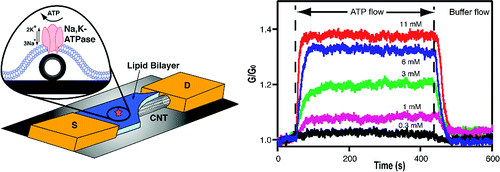Nanotube transistor will help us bond with machines
May 14, 2010 | Source: New Scientist Tech
Lawrence Livermore National Laboratory researchers have developed a novel transistor, controlled by ATP (the chemical that provides the energy for our cells’ metabolism), that could be a big step towards making prosthetic devices that can be wired directly into the nervous system.
The transistor comprises a carbon nanotube, which behaves as a semiconductor, bridging the gap between two metal electrodes, and coated with an insulating polymer layer that leaves the middle section of the nanotube exposed. The entire device is then coated again, this time with a lipid bi-layer (similar to those that form the membranes surrounding our body’s cells) using a protein that, when exposed to ATP, acts as an ion pump, shuttling sodium and potassium ions across the membrane.
The build-up of ions creates an electric field around the exposed portion of the semiconducting nanotube, increasing its conductivity in proportion to the strength of the field. When the supply of ATP is reduced, ions leak back across the membrane and the flow of current through the transistor falls.
